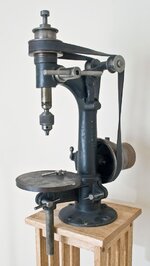GaryMGg
Member
As some of you know, I'm living in two places.
My main shop has a great OWWM drill press with a 4" spindle stroke.
My secondary shop--where I am most of the time--has a tabletop Craftsman with a 2" stroke.
Of course, 2" is less than the length of most blanks.
Any good ideas for modifying the DP to obtain greater depth and maintain accuracy?
The vast majority of drilling would be for slimlines.
Thanks for your good thoughts.
My main shop has a great OWWM drill press with a 4" spindle stroke.
My secondary shop--where I am most of the time--has a tabletop Craftsman with a 2" stroke.
Of course, 2" is less than the length of most blanks.
Any good ideas for modifying the DP to obtain greater depth and maintain accuracy?
The vast majority of drilling would be for slimlines.
Thanks for your good thoughts.


